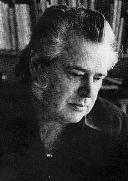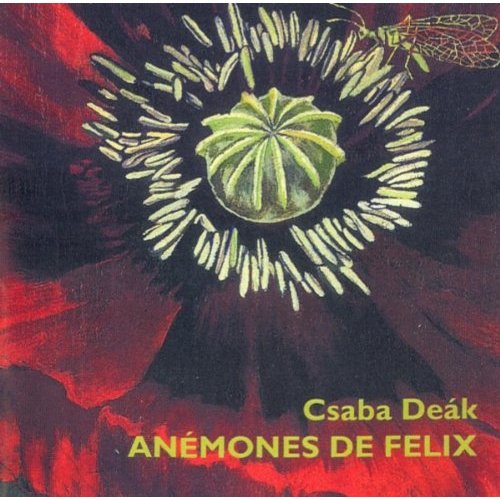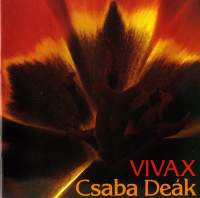
CSABA DEAK born 16th April 1932, Hungary
Tim Reynish, November 2012
One of the most significant composers of wind music of our times has recently passed his eightieth birthday, a stalwart member of WASBE since its inception in 1981.
Among contemporary Swedish composers, Hungarian-bom Csaba Deák (b. 1932) occupies a special position by virtue of his prolific output of wind music. He studied clarinet and composition at the Franz Liszt Academy, Budapest, and with Hilding Rosenberg in Sweden. During the 1960s he wrote I 21 for wind instruments, and hisGustadolphony was written for an American college in 1990. His Five Short Pieces have been performed by numerous groups. Altogether, he has made ten or more significant contributions to Sweden's fairly meagre original repertoire for wind band. Nevertheless, his close involvement with the development of wind music has also meant a great deal to Swedish music.
Leif Jansson
It is easy to compare (the Clarinet Concerto) with solo concertos by other Hungarians: from Ferenc Liszt and Béla Bartók to György Ligeti and György Kurtág
Hans-Gunnar Peterson, CD Notes to Anémones de Felix
Pay attention to this composer! The music is hard but logical, music of today! Be sure to look at other things in the SMIC catalogue by Deak.
Mark Lammers, WASBE Catalogue Nordic Instrumental Music
The programmes for a WASBE Conference are almost invariably the result of compromise, compromise with conductors, with soloists, with the artistic planning committee and the local organising committee, but my greatest sadness in 2003 when planning the 2003 WASBE Conference in Jönköping was that we were forced to drop a masterpiece for choir and wind orchestra, Memento Mare, by Csaba Deak, who was eighty earlier this year. I am listening to it as I write, an austere, beautiful requiem for the ferry Estonia which sank in September 1994, with the loss of 852 lives, 138 being rescued. A few months earlier, my wife and I had crossed to Tallinn on the Estonia, and we had reflected on how formidable, cold and sinister the Baltic Sea looked at night, even when calm.
Born on 16th April 1932 in Budapest, Hungary, he first studied at the Bartók Conservatory 1949-1955 (clarinet and composition), then composition with Ferenc Farkas at the Liszt Academy in 1955-1956 and later with Hilding Rosenberg in Stockholm. (Deák emigrated to Sweden in 1957.) He graduated as a teacher of the theory of music from the State Academy of Music in Stockholm, 1969 and taught at Gothenburg University, 1971-1974, as well as at the National College of Dance in Stockholm. He was a founding member of WASBE (World Association for Symphonic Bands and Ensembles) and from 1987 he was a member of the board of the Swedish section of WASBE, heavily involved in the artistic planning of the WASBE Conference in 2003.
Soon after his arrival in Sweden, Csaba Deák came into contact with Hilding Rosenberg, which resulted in a knowledge of contemporary methods of composition being added to the thorough training which the young composer had already received before. His first string quartet is based on a twelve-tone melody, and so too are several other works from the 1960s. Since then Deák has evolved personal systems which are by no means entirely free but are flexibly varied from one composition to another. One common practice of his involves mingling free and regular metre, as he already did in I 21 for wind instruments and percussion (1969). One important piece is Piri for mixed choir and percussion instruments, written in 1974 to a kind of nonsense text using puns, onomatopoeia etc.

There is a CD available entitled ANÉMONES DE FELIX, (NOSAGCD053) which gives a valuable oversight of the style of Csaba Deák. Indeed on Amazon, you can purchase the MP3 Download for a mere £7.93 or the three movement Clarinet Concerto for 59 pence each movement. If you enjoy contemporary music of the last 100 years, since Mahler’s Ninth Symphony, Schoenberg’s Pierrot Lunaire and the Berg Altenberg Lieder, you will enjoy the terse, energetic but also lyrical, sometimes austere and usually challenging output of Csaba Deak. Not being a scholar, I find it difficult to assess his music, but I find affinities with that Second Viennese School, perhaps with the musical language of Gunther Schuller, although there is a greater clarity in Csaba Deak, and more variety. Busy textures will suddenly pause and a slowly moving Klangfarbenmelodie is developed, climaxes build and disappear as rapidly, and there is a wry humour underlying much of his work, with a natural affinity for writing for wind and brass, born from being a Hungarian clarinettist.
Csaba Deak at 80! How do we assess his contribution to the world of wind repertoire when so little of his music appears in our programmes or in YouTube performances? Luckily, we have as an aide memoire the WASBE catalogue of Nordic Instrumental Music for Schools and Colleges by Mark Lammers, revised in 2007. With every work there is usually a little descriptive entry, giving the orchestration and a comment, and these build up quite a good picture of Csaba Deak, the man, the musician, the composer.
Luckily too that there are a number of his works on various CDs available through Naxos and other suppliers.
CHAMBER MUSIC
First, his chamber music is extensive and a list and notes culled from Lammers might be useful. In the Naxos catalogue a number of important works have been recorded
PS-CD32 Entitled VIVAX this Chamber Music disc opens with his striking Quintet for Alto Saxophone and String Quartet, written in 1988 after he had been living in Sweden for thirty years. This is a brief, pithy work, grounded in the Central European traditions of composers like Bartok and Kurtag. Csaba had for many years planned to write a wind quintet and his first essay in 1977 was an Octet for wind quintet and string trio of violin, viola and cello, a one movement work of about ten minutes. It is a work of strong contrasts, contrasts of speeds, instrumental colours, always maintaining the listeners interest, contemporary yet engaging. The Octet is one of Csaba Deak's largest-scale chamber works, and it exhibits his characteristic feeling for varied instrumental timbre (listen and you will find many examples of personal musical mixture of colours!). But the piece is also original by virtue of its strict construction and the austere expression.
His Saxophone Sonatina is on a disc entirely of Saxophone music, CSCD-96015, and is a five minute unaccompanied divertimento, more lyrical and charming than some of his music, with brief memories of his Hungarian roots
Andante & Rondo Wind Quintet 6.00 Reuter Well crafted work from excellent wind music composer
Fuvola solo flute 6.00 SMIC Uses advanced techniques, a composer always worth the effort
Herykon Brass Quintet 9.00 SMIC non-
Sax Appeal Sax Quartet 8.00 SMIC The music is hard, maybe too difficult for most student groups, but get acquainted with the work and the composer. He structures difficult passages so that with some attention they become playable
Ungerska Dancer Wind Quintet SMIC Fine composer and a playable piece
Verbunk Brass 6tet 8.00 Suecia Well developed score, use of metric changes
ORCHESTRAL MUSIC

VIVAX is an extraordinary one movement orchestral work, written to celebrate the 75th anniversary of the founding of the Swedish Musician’s Union, and is the second work on the disc of chamber music. His own description of Vivax gives a wonderful picture of that work: The material in the composition's first and last parts is based on the typical playing style of one of the greatest musical entertainers, the Hungarian gypsy violinist. Now it may seem odd that I am making use of a Hungarian musical style to celebrate the Swedish Musician's Union. But ... the work is meant to be a homage to a profession whose task it is to communicate with a language that can be understood far beyond national boundaries. So it is actually a matter of course that I blend in some tones from a country where I was born and grew up, in a music that I write in another country where I now live and work.
WIND ORCHESTRAL MUSIC
Anémones de Felix 12.00 SMIC
This is a musical tribute to Felix Hauswirth, for so long artistic director of the Internationale Musiktage in Uster where the work was premiered in 1994. A review from the premiere spoke of the music of Alban Berg, and certainly Deak does not compromise in his musical language. Lammers writes: Musical surprises, but always musical – that is Deak. The work will take a lot of score study by the conductor and practice by the players to make it work. The product will be worthwhile, I know Deak.
Csaba writes of the thoughts he has of the Actiniara, a Sea Anenome, with a mouth that opens, closes and opens again. In a similar way the chords and clangs of my piece open and close, followed by others opening and closing.
Clarinet Concerto 17.58 SMIC
Lammers’ note reads: Usual three movements, but nothing usual about this composer or this work. For those who must have a challenge from a composer who enjoys making it for you. A major work!
He is absolutely right, it is a major work. With a canvas of over seventeen minutes, the composer is able to explore a wider range of emotions and he demonstrates a lyrical quality which is sometimes lacking in his shorter works. It was written specifically for Kjell Fageus who for twenty four years was principal clarinet with the Stockholm Opera, and while it exploits his virtuoso playing there are passages of a limpid simple beauty. The opening consists of a series of elegiac cadenzas, and the composer has pointed out the musical connections between unaccompanied Hungarian folk ballads and the language of the mourning blues mood.
Five Short Pieces for Symphonic Band 10.00 Gerhman
The WASBE catalogue notes: an excellent score, non-traditional notation in movements 2, 4 & 5, with good explanations. Very playable work.
Five quirky little movements, rather more contemporary than the Pequena Suite by Luis Serrano Alarcon, more similar to the experiments by Dubrovay in his Little Suite, but with a teasingly rhythmic, melodic and harmonic freedom which will intrigue your players, if they are ready for it
Farina Pagus 11.20 SMIC
Peterson describes this as a miniature, an overture or interlude, frothy and amusing.
Memento Mare 12.33 SMIC
I wrote about this recently for the WASBE LinkedIn account as follows:
MUSIC FOR CHOIR AND WIND BAND
– A MASTERPIECE
Good to read in our discussion forum about music for choir and band.
When their discussion messages came though, I was listening for the
second time this morning to a masterpiece I had forgotten, Memento Mare, a twelve
minute elegy by Swedish/Hungarian composer Csaba Deak, eighty this year.
Written in memory of the 852 passengers lost in the 1994 sinking of
the ferry Estonia this is a really marvellously evocative piece, a setting
of part of the Requiem Mass, ternary form with a short angry central
section which then recaptures as a coda the serene mood of the opening.
It is available as an MP Download on Amazon, Nossag CD 053. We failed
to get it programmed in WASBE 2003, but I want to conduct it now. Happy
Birthday, Csaba.
Finally two outstanding symphonies, which need professional or excellent university bands to tackle.
SYMPHONY FOR WIND is the final work on this splendid disc, a seventeen minute work, challenging yet totally engaging in its virtuoso use of the wind orchestra. Completed on Christmas Day, 1995, the sleeve note puts the work firmly alongside the Symphonies of Wind Instruments by Stravinsky, Messiaen’s Et Exspecto and works by Varése, works with a similar mastery of wind, brass and percussion sonorities. Here, as in many of his works, he makes use of metric and non-metric improvised passages.
SYMPHONY NO 2 is recorded by the Stockholm Wind Symphony on NOSAGCD085; this is also a one movement work of about 18 minutes in length and repays repeated hearings. It is powerful, full of imagination and hugely varied in its treatment of the instrumental forces. Again, the language is uncompromisingly contemporary, but any conductor and wind orchestra who is searching for a work perhaps cast in a lingua franca of the contemporary scene post 1980, this is a work for you. There is a mix of energy and lyricism, a wonderful harmonic richness and freedom of metre and rhythm and an originality which is rarely sustained in large-scale wind works.
| ANEMONES DE FELIX | SMIC | 1993 | 12 MIN | 3FL(PIC),OB,BSN,3CL,BCL,AS,TS, |
| CONCERTO FOR CLARINET & WIND ORCHESTRA | SMIC | 1992 | 18 MIN | 3FL(1 DBL PIC,
3 DBL ALTO FL) 3 OB (3DBL ENG HN),1 EbCL,3CL,BCL,BbCONTRA
CL,3BSN (3 CONTRA),AS,TS,BARS.3TRPT,3HN, |
| CONCERTO MAEUTRO (FOR MARIMBA,EUPHONIUM & TRUMPET) | SMIC | 1989 | EST 12+MIN | 3FL,3CL,BCL,OB,BSN,AS,TS,BS, |
| EDEN | GEHRMANS | 1981 | 8 MIN | PIC,2FL,EbCL,3CL,BCL,OB,BSN, |
| FIVE SHORT PIECES | GEHRMANS | 1983 | 10 MIN | PIC,2FL,3CL,BCL,OB,BSN,2AS,TS, |
| GUSTADOLPHONY | SMIC | 1989 | 10 MIN | PIC,3FL,EbCL,3CL,BCL,2OB,2BSN, |
| HERYKON | SMIC | 1981 | 9 MIN | SOME NONTRADITIONAL MATERIAL, EASY TO UNDERSTAND. CHANGING METER. MUSIC THAT IS FUN FOR PLAYERS AND THE AUDIENCE. |
| I 21 | GEHRMANS | 1969 | 10 MIN | PIC,FL,EbCL,3CL,OB,BSN,AS,TS, |
| MAYINKA | SMIC | 1999 | 14 MIN | 3FL(PIC),OB,EH,2CL,BCL,2BSN( |
| SAX APPEAL | SMIC | 1999 | EST 8 MIN | SS,AS,TS,BS. COMPOSER WRITES - WE PAY ATTENTION. THE MUSIC IS HARD, MAYBE TOO DIFFICULT FOR MOST C/U STUDENT GROUPS, BUT GET ACQUAINTED WITH THE WORK AND THIS COMPOSER. HE STRUCTURES DIFFICULT PASSAGES SO THAT WITH SOME ATTENTION THEY BECOME PLAYABLE. |
| SYMPHONY NO. 2 | SMIC | 2001 | 18 MIN | 3FL(DL PIC,AFL),OB,EH,2BSN,EbCL,3CL, |
| THE PIPER'S WEDDING | SMIC | 1979 | 12 MIN | PIC,2FL,3CL,BCL,OB,BSN,AS,TS, |
| THE PIPER'S WEDDING | SMIC | 1979 | 12 MIN | PIC,2FL,3CL,BCL,OB,BSN,AS,TS, |
| VIVAX | GEHRMANS | 1985 | 20 MIN |
I suspect that the Lammers catalogue might now be incomplete; it has no mention, for instance of the first Symphony for Wind. It is worth noting that the Concerto Maeutro for Trumpet, Euphonium and marimba soloists was played in the 1991 WASBE Conference by the International Youth Wind Orchestra, conducted by Per Lyng, but sadly few of his works have appeared at WASBE. His is an original, individual voice, one of the few composers of our time who has written for the wind orchestra fully acknowledging the great legacy of contemporary music of the past century.
Happy Birthday, Csaba, and many thanks for the richness of your catalogue.